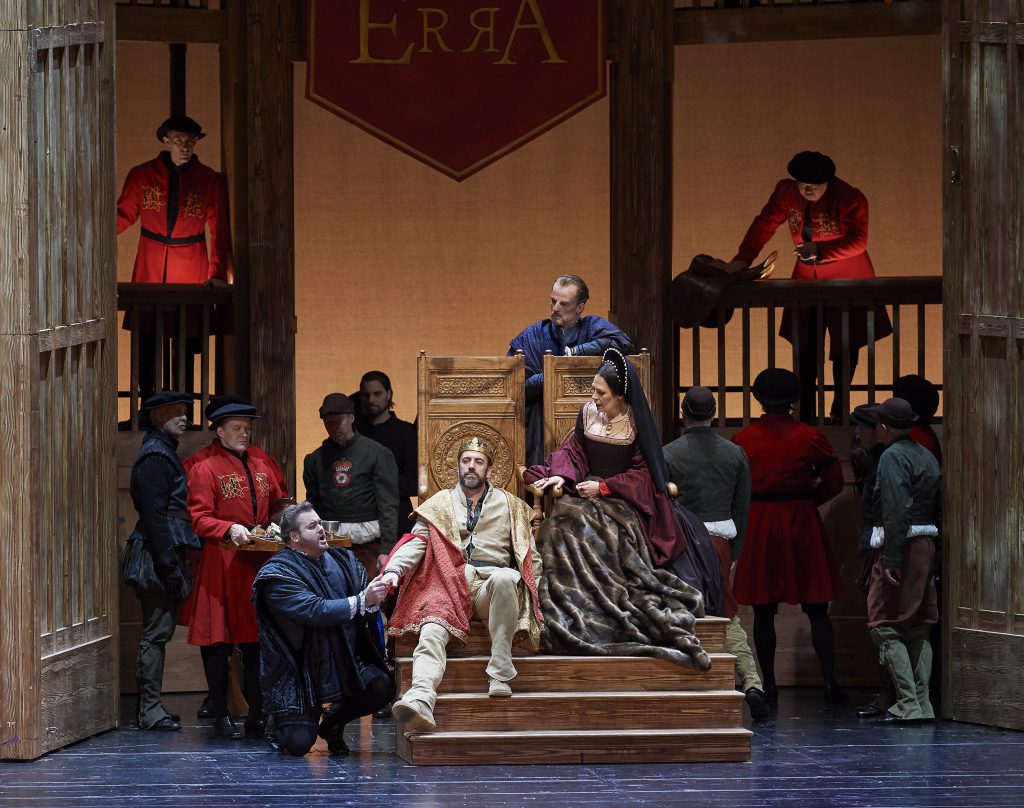Anna Bolena. Maria Stuarda. Roberto Devereux.
Gaetano Donizetti’s Tudor trilogy, a supremely operatic mid-19th century Italian portrait gallery of quintessentially English Renaissance royals, earned its young musical architect almost instant international stardom. The surge of enthusiasm for the Three Queens, as the trio of tragedies came to be known, could not have been entirely unexpected given the spirit of the times.
World weary audiences up and down the Italian peninsula, hungry for new talent, were universally captivated by the handsome, debonair Lombard, heir apparent to the venerable Gioachino Rossini, retired for almost a decade prior to the enterprising 30-year old’s trio of stylish break-out hits. In Paris and Vienna the attraction was every bit as fervent albeit more involved, driven in no small measure by a wave of popular enthusiasm for English romanticism in a bitter age of failed post-Napoleonic values. Westwards across the Continent, Londoners, then as now, needed no encouragement to celebrate their extended national heritage made more colourful by Donizetti’s narrative reimaginings. A deft hand at promotion after penning scores for over two dozen earlier works, the composer played to his fan base, methodically constructing his franchise, unapologetically restructuring history to suit a very contemporary pan-European marketplace.
Arguably the most sentimental episode in Donizetti’s impassioned regal cycle, certainly the least troubled by issues of dramatic licence — Realpolitik discarded in favour of matters of the heart — Anna Bolena lands, with ringing highs and lows, on Toronto’s Four Seasons Centre stage, concluding the Canadian Opera Company’s 2017/18 season. Vocally vivacious, grimly emphatic, Stephen Lawless’ almost decade old production, transplanted from Dallas Opera where it premiered, disappointingly fizzles as staged drama despite the best efforts of a cracking, red hot cast to fan the directorial flames back to life.
Treating Henry VIII’s court and, by implication us as well, as spectators to some prototypical period piece at Shakespeare’s iconic Globe Theatre, Lawless essentially treats history as allegory, layering the all-too familiar tale of Boleyn’s execution for alleged infidelity by an agenda-minded king with visual metaphor. Vileness and deception are tangibly on show. Faux oaken walls constantly shift and re-arrange themselves to form new playhouse settings, virtually the only physical aspects of this bloodless Anna Bolena that behave with any degree of animation. The tyrant King rarely rises from his throne. The saintly Queen anchors herself to her fate. Stiff rows of anonymous lords and ladies peer stonily from the Gallery.
With Benoit Dugardyn’s set and Lawless’ original staging sharply mirrored in COC-hosted productions of Maria Stuarda in 2010 and Roberto Devereux in 2014, a conceit that once seemed fresh and insightful now feels trite. The past may well be immutable, our interest in Anna’s horrific demise vicarious as this blunt Bolena implies, but the notion of theatre-in-theatre-in-theatre only engages for so long. And the music plays on.
Librettist Felice Romani, notorious for missing deadlines, was late delivering final scenes to Donizetti, forcing him to scramble in advance of Anna Bolena’s scheduled Milan opening on December 26, 1830. Finished and rehearsed in a frantic 4½ weeks, the protracted two-act opera’s glossy, intricately ornamented score bears little if any trace of compositional hastiness. What Donizetti achieved, in fact, was far more than bel canto pastiche. Relaxing the rigid rules associated with every operatic entrance and exit — a cappella exposition/decorative vocal adagio/bouncy singsong coda — Bolena struck out on a path that would ultimately wind its way to Verdi. Recitative was infused with emotion. Arias, while still offering spectacular, pyrotechnical opportunities for daring soloists, cut straight to the heart. Ensembles were greatly expanded from mere duets, trios, and the occasional quartetto. The spectacular sextet that closes Act I, Ah! segnata è la mia sorte (“Ah! My fate is sealed”) was nothing short of revolutionary in Donizetti’s time. And still thrills today.
Conducting a sprawling 62-player Canadian Opera Company Orchestra plus plucky 9-member banda, visiting maestro Corrado Rovaris leads with fine poise and polish, clearly mindful of Donizetti’s long, endlessly unforgiving vocal lines. Principals are abundantly supported. An occasional note of over caution, however, particularly pronounced in Rovaris’ choice of tempi, results in unnecessarily languid instrumental passages. Overture and entr’acte lack crispness and crunch.
And then Sondra Radvanovsky sings and, in that moment, all the irritating directorial contrivance, all the weariness almost, but not quite, slips away in an overpowering rush of elation. This is a voice of unsurpassed drama and spinto virtuosity in the enduring tradition of Maria Callas, a singer actor often associated with her and the one responsible, more than any other artist, for rescuing Anna Bolena from 20th century commercial oblivion when La Divina immortalized the role at La Scala in the late 1950s.
It is, of course, Donizetti’s celebrated mad scene that catapults Bolena into the realm of overt human psychology to such excruciating effect. Piangete voi? donde tal pianto? (“Are you weeping? Whence such tears?”), sings Radvanovsky, tracing the soon to be executed Queen’s descent into hysteria with dazzling precision in the first in a string of punishing arias. The breadth of expression on show here is extraordinary. But it is Anna’s little prayer earlier in Act II, Dio che mi vedi in core (“God who sees into my heart”), as sung by the Caledon-based soprano, a flash of hope in the gathering darkness, that somehow resonates the strongest. Radvanovsky’s capacity for tenderness is deeply moving.
Appearing as Lord Riccardo Percy, the former lover Anna cannot quite forget, tenor Bruce Sledge brings an explosion of bright, luminous colour to the deathly dark business of imprisonment and torture. With an urgent rendition of the soaring manly showpiece, Vivi tu te ne scongiuro (“Live I implore you”), Sledge commands attention, his previous love scene with Anna dangerous and inflamed.
Bass-baritone Christian Van Horn is a sinister Enrico. Deprived of stand-out arias by the composer, this Henry, a master of sinister declamation, fumes with king-sized menace, moody and malicious.
Soprano Keri Alkema appears as Lady Giovanna Seymour, Anna’s rival, the future queen, delivering a finely gauged performance ringing with helplessness and guilt.
Mezzo-soprano Allyson McHardy is Smeton, the besotted, boyish musician destined unwittingly to betray Boleyn. Her rendition of Donizetti’s catchy serenade, Deh! Non voler costringere (“Ah! Do not let desire constrain a face intended for joy”), however abruptly curtailed by Donizetti in a clever piece of musical authorship, quite simply enchants.
Bass-baritone Thomas Goerz is Anna’s brother, the faithful Lord Rochefort. Tenor Jonathan Johnson is Enrico’s shadowy henchman, Hervey, a man of few words and abundant villainy.
In frequent appearances as courtly commentators and observers, the men and women of the Canadian Opera Chorus sing with both potency and refinement, the latter singing with particularly notable unity of purpose in the great poignant chorale, Chi può vederla a cigio asciutto in tanto affano (“Who cannot be moved and heartbroken”).
For all its musical grandiosity, Anna Bolena is not indestructible. To maintain Donizetti’s sense of theatricality, strongly flavoured by melodrama, requires keen oversight. Branding it Shakespearean, as director Lawless insists, does not make it so. Or confer added gravitas.
* * *
Above: Bruce Sledge as Riccardo Percy, Christian Van Horn as Enrico VIII, Thomas Goerz as Lord Rochefort, Sondra Radvanovsky as Anna Bolena. Photo: Michael Cooper


